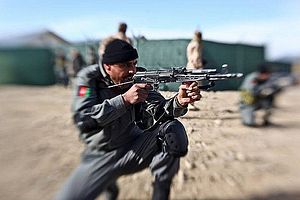On April 12, the Afghan Taliban announced the launch of their annual spring offensive in Afghanistan: “Operation Omari.” The spring offensive has been named after the movement’s late founder Mullah Muhammad Omar. Ahead of the offensive, the statement on the Taliban’s website mentioned the use of large-scale attacks against government positions, while employing a combination of hit-and-run assaults and suicide attacks in urban areas. And indeed this week a major blast in Kabul killed at least 64 people.
This year’s fighting season will determine the future trajectory of the Afghan conflict, as civil war looks imminent.
While there was no lull in the fighting in Afghanistan throughout 2015, the announcement of the spring offensive could signal a further escalation of violence, accelerating the country’s destabilization. Since the withdrawal of international troops from Afghanistan in 2014, the Taliban have grown from strength to strength, despite initial setbacks emanating from the disclosure of their leader Mullah Omar’s death in July last year. Last year’s violence left 11,000 civilians dead across Afghanistan.
The launch of the spring offensive by the Taliban is a major setback for the fledgling peace process in Afghanistan. A Quadrilateral Coordination Group (QCG), comprising China, the U.S., Pakistan and Afghanistan was created in December last year in Islamabad to revive the stalled peace talks between Afghan government and the Taliban. The QCG held four meetings – two in Islamabad and two in Kabul – but failed to overcome differences on the operational details of negotiations. Notwithstanding these differences, the QCG was hoping to hold the first direct meeting between Kabul and Taliban in April. However, the spring offensive has dashed hopes that a political solution will be found to the Afghan conflict.
Right from the outset, irreconcilable differences existed between Kabul and the Afghan Taliban – differences that made the peace process a non-starter. For instance, the Taliban unequivocally demanded the release of prisoners, removal from the UN’s sanctions list, the easing of travel bans, and recognition of the Qatar office as the Taliban’s official political office for peace talks. In contrast, the Afghan government called for condition-free peace talks, arguing that the demands should be discussed during talks. Second, the Taliban wanted a timeframe from the Afghan government for the complete withdrawal of U.S. troops from Afghanistan, something Kabul was not ready to grant (under the Bilateral Security Agreement, U.S. troops can stay in Afghanistan until the end of 2024). Finally, Kabul aimed at reaching a power sharing agreement with the Taliban in exchange for a cessation of violence and the Taliban’s recognition of the Afghan government and constitution. In contrast, the Taliban saw peace talks as one means, among others, to return to power.
The Taliban has been buoyed by last year’s military victories in Afghanistan. The senior leadership of the Taliban has defied the pressure of Pakistan’s powerful military establishment by plainly refusing to talk to Kabul. By doing so, they have emerged out of the shadows of Pakistani military’s dictates and have done much to dispell their image as a proxy.
Ahead of the spring offensive, the new Taliban leader Mullah Akhtar Mansoor has emerged as the legitimate and undisputed leader of the militant movement. Masnoor has not only succeeded in stitching up the cracks that emerged within the group following the disclosure of Mullah Omar’s death, but has also succeeded in shifting the momentum of battlefield victories into a nuanced political narrative in the eyes of the Afghan populace. The recent inclusion of Mullah Qayum Zakir, an influential military commander, along with Mullah Mannan and Mullah Yaqoob, the brother and elder son of Mullah Omar, will further strengthen the Taliban’s military position and dispel the impression of internal disputes and weaknesses. The leader of the Haqqani network, Sirajuddin Haqqani, has played an important role in bridging these differences. More importantly, several influential commanders and fighters of IS-Khurasan, the local ISIS affiliate, have re-joined the Taliban. The Mehsud faction of the Pakistani Taliban has also merged its fighters with the Afghan Taliban.
Continuing last year’s strategy, the Afghan Taliban is launching operations in both the south and north of the country, to stretch out the Afghan security forces. The focus of this spring offensive will be on capturing more territory to strengthen their position and expose the weaknesses of the Afghan government.
The spring offensive will have a direct impact on Afghanistan’s relations with its neighbor Pakistan. As the fighting escalates, the blame game between Kabul and Islamabad will intensify. The Afghan government will try to exert pressure on Pakistan through the international community and the U.S. to act against Taliban sanctuaries on its soil. Specific demands could include arresting top Taliban leaders or chasing them out of Pakistan.
The escalation of conflict in Afghanistan will also have negative fallout at the global level. It will result in a flow of Afghan migrants to European countries, which are already grappling with a flood of refugees from Syria. Given the uncertainty surrounding its future and growing unemployment, Afghanistan is experiencing a rapidly worsening brain drain. The deterioration of the situation in Afghanistan will also put pressure on the international community to increase their financial contributions to keep the U.S.-backed Afghan government afloat.
The diminishing hopes of a political settlement of the Afghan conflict with defiant Taliban posturing has increased the prospect that Afghanistan will once again slide into chaos. If it does, a lingering conflict will become a festering wound for the region.
Abdul Basit is an Associate Research Fellow at the International Centre for Political Violence and Terrorism Research (ICPVTR) at the S. Rajaratnam School of International Studies.

































